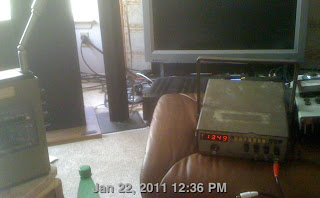Pretty far out, my left channel has solid frequency response from 14Hz to 35kHz (though I am not equipped to measure 35kHz, but I can tell there is output there, and that is the supertweeter specification from Elac also). Few systems can achieve 20-20k, most audiophiles are content with 40-18k, and non-audiophiles breath in 120-5k.
And perhaps I shouldn't brag about this, but the extremes in this 14Hz-35kHz are not rolled off, or at least the 14Hz isn't. Output is just as strong at 14Hz as it is at 1Khz, and the subwoofer doesn't even seem to be moving at all. Why I should be bragging is that if I have problems, it is not so much at the extremes, it is in the middle. And all audiophiles know you have to get the middle right first. Well my middle is pretty much all the Acoustat 1+1 speaker, one of the most well regarded speakers in audio history. But by the standards of frequency flatness in my room, it does not at all have flat frequency response. It has too little lower midrange and too much upper midrange. But I am planning, ultimately, to fix that with my Tact RCS 2.0. But even as it is now, with considerable variation in the middle range frequency response, it sounds very very good.
And I am running those supertweeters from 14kHz to 35kHz. (So now you can see the title of this blog entry is also a pun.)
Last night's liveblogging gave you a feel for what would have been 10 minutes of fiddling if I hadn't been trying to blog also, which turned it into an incredibly tedious 45 minutes. It also gave you a feel for how inconsistencies are constantly popping up and you have to decide which ones to investigate. That's just the way it is being an Audio Investigator.
But what I've done since last night is to fully sweep out the left channel (which looks just as good or better than the right...goes down 1Hz lower!). And get around to re-adjusting the supertweeter crossover, which hadn't been done after I raised the supertweeter level from +10 to +15 on the Behringer crossover.
The intent, all along, has been smooth transition between drivers, with no bulge or notch at the crossover. On the supertweeter, I am not lowpassing the Acoustat panels, I am letting them naturally roll off. I thought they naturally rolled off around 18kHz, but my measurements are making it look more like 14kHz. They certainly begin to take a dive at 14kHz, and I found some other measurements on the web to confirm that. In the lower 14kHz range, a serious drop out begins unless you start filling it in with the supertweeter, which is what (at great effort) I have accomplished.
So my intent is to begin the supertweeter at 14kHz. Previously, at the +10dB level, I had decided the correct crossover point was 14.8kHz. Now, in the right (other) channel, and +15dB level, it seems the output doesn't drop -6dB (as would be required by Linkwitz-Riley crossover type) until 12kHz. After many minutes of fiddling and measuring (with the meter needle swinging wildly because of the pure sine waves I am using because I don't have a warble generator) I found that 16.5kHz was required to make the supertweeters have a 14kHz acoustic cutoff (so the nice "filling" described in the above paragraph actually happens, without contributing to peaks caused by the Acoustat below 14kHz...or at least contributing more than a tiny amount).
Now why it is necessary to adjust the crossover to 16.5 kHz (as high or higher than I set it last year...before the supertweeter religion really set in) when what I want is a 14kHz crossover? I often (but incorrectly) assume that the combination of the supertweeter's own built-in crossover (at 8kHz or so) and my electronic line-level crossover (which is in cascade with no interaction) would raise the crossover point, so if I wanted 14kHz I'd need to set 12kHz (?)
Now I think it works the other way, perhaps the supertweeter's built-in crossover, if it is having any significant effect at all, would be to LOWER the high pass cutoff from whatever I set. So it could actually be (though I doubt this is the entire explanation) that I would need to set a 16.5kHz cutoff to actually get 14kHz, just as I have done.
Or maybe it's something else that I haven't thought of yet.
But that's the way these things often are. Anyway, my measurements suggest that at the +15dB level, I need a 16.5kHz cutoff to get nice separation between the Acoustat panels and the Elac supertweeters at 14kHz.
I'm hoping this won't kill the magic time travel I've been experiencing through audio since I boosted the supertweeters to +15dB a few days ago.
(BTW, clarification of earlier post, supertweeter amplifier now has a 6dB attenuator.)

No comments:
Post a Comment